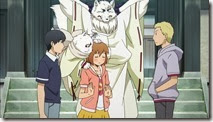 |
 |
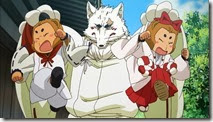 |
This show is a kind of “The more you know” for Japanese spiritualism…
This episode certainly didn’t pack the kind of emotional punch the last few have, but that’s fine – it didn’t try to. You wouldn’t want that kind of gravity for 13 episodes, I don’t think – especially in a show that started out as a laid-back feel good story as Gingitsune did. I mentioned yesterday that Diamond no Ace was probably going to operate at full effectiveness mostly for people who liked baseball, and I wonder if the same is true here to some extent when it comes to Shinto and Buddhism – even without any dramatic heavy lifting I’m geeky enough about this sort of thing to eat an episode like this for breakfast.
Bear with me if you don’t care about this sort of thing, but it does interest me so I’m going to talk about it for a bit. A lot of Westerners and even non-Japanese Asians struggle differentiating Buddhism and Shinto, and indeed the two have been quite intermixed over the last 1400-odd years that they’ve co-existed here. In the most basic sense, Shinto is the native religion of Japan, the one that predates written history. Buddhism came here in the 6th-Century, via Korea (having originated in India of course, and passed though most of Asia on the way). As you saw in this episode (and as Makoto mentioned in the preview) the Shrine (Jinja) is the place for Shinto worship, and the Temple for Buddhist worship.
But it isn’t nearly that simple. There’s a saying that “Japanese are born Shinto, married Christian and die Buddhist”. In truth the modern Japanese spirituality is mostly a mix of Buddhism and Shinto – most Japanese have small household shrines – “Kamidana” – on a shelf somewhere in their house, and nearly all have a Buddhist funeral. There’s a lot of politics involved in the history of the two religions – Japanese nationalists have often railed against Buddhism as impure and “not Japanese”, a sentiment which gave birth to the State Shinto cult. Many Buddhist Temples, as did the one in this episode, actually have Shinto Shrines on-site, and – again as this one did – may even be built on the site of an older Shinto Shrine. Then there Shugendou (as seen in Red Data Girl) which is almost purely a mix of Shinto and syncretic Buddhism…
In truth these two belief systems could hardly be more different in some ways – one them being in the way they treat death. You’ll never see a graveyard on the site of a Shrine – unless it’s on Temple grounds – because in Shinto, death is the most impure thing of all. Purity is of crucial importance in Shinto – it’s why every sizeable shrine has basins to cleanse the mouth and hands, and why the Japanese are so culturally obsessed with bathing. So when the annoying little monkey Heralds, Fuu-tachi, seemed so perplexed and disturbed by all the crying humans at funerals, that’s why – a Shrine Herald would never see a funeral. In effect what we’re seeing here is a culture clash – Shinto spirits who have no context for dealing with life at a Buddhist Temple, and no humans around with The Sight to smooth the way.
That said, they certainly were a handful – monkeys in form and character. Even Haru was mature compared to them – well, except for allowing them to completely piss her off and make her cry. Of course the best part was seeing dour old Gintarou deal with the little buggers – as usual he claims he’d rather not be bothered, but doesn’t resist that hard when Makoto drags him into the situation. The best part of all this for me was the way it juxtaposed the Shinto and Buddhist belief systems in such a way as to make the differences really apparent. It’s a little too simple to say the Japanese Gods are “about as irresponsible as you can get”, as Gin does – but there’s definitely a difference in temperament between Shinto and Buddhism that’s easy to see here.
Now that Satoru and Haru are firmly established as effective co-leads, Gingitsune seems to be entering a new phase of exploring its world with a little more depth. That means a little more to do for Yumi’s boyfriend Shoehei (I should have mentioned earlier he was played by Seki Tomakazu), the scion of the Temple, and it seems as if Sugita Tomokazu will finally be appearing next week (we have two Sekis and two Tomokazus in this show, so no need to push, there’s plenty for everyone). We’ll see if the series can maintain it’s narrative drive over the last five episodes – I do think it’s been better when dealing with weightier matters, generally – but it feels as if the story is only scraping the surface of its potential, so I’m not too worried – if anything, this is a series that really screams out for a two-cour run.
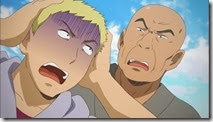 |
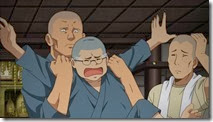 |
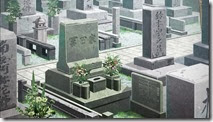 |
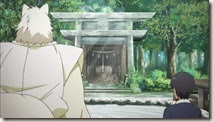 |
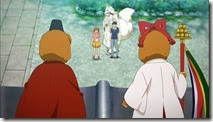 |
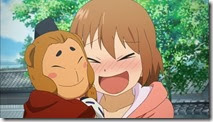 |
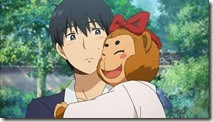 |
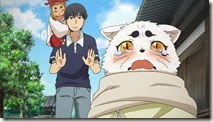 |
 |
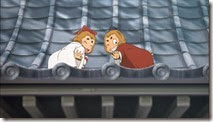 |
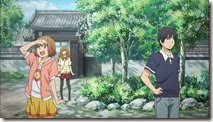 |
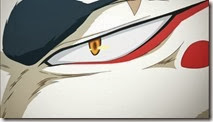 |
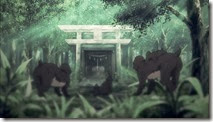 |
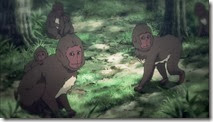 |
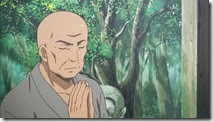 |
 |
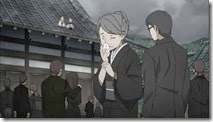 |
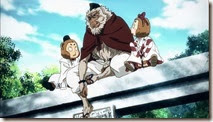 |
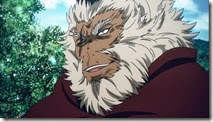 |
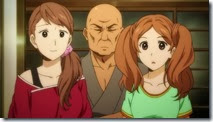 |
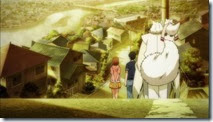 |


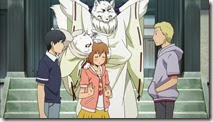
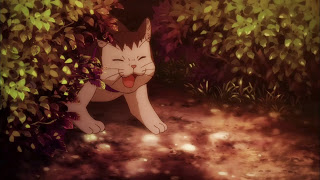
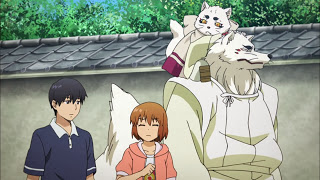
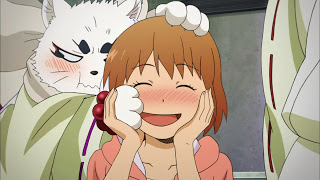
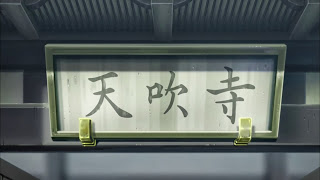
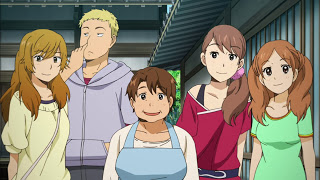

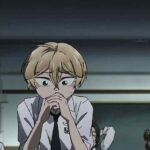
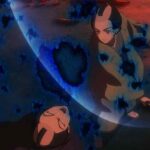
thedarktower
November 18, 2013 at 3:58 pmyou nailed the difference between shrine and temple, Shinto and Buddhism and its past. something that this episode didn't intend to do (and it didn't happened). yes, there was actually a reminder for the issue, yet it remained somewhere floating in the air as reminder for us. I think it's for the best.
having said that, it was simply a mid-episode. not that touching like those before. and it's OK. sometimes a relief is needed, yet it was special enough for Gingitsune-style. it actually had an interesting point with the monkeys.
we discovered that the monkeys aren't just trouble-makers as one should think. and really they had their reasons. it may sound stupid reason, but IMHO it was a simple and genuine one. they are "children-heralds" and without anyone around(aka old-monkey) in such a sad place, they can't fully understand what's going on. besides, they were kinda lonely without anyone able to see and communicate with them a bit. in that matter, I think it's great that every shrine must have 2 heralds at the same time. otherwise, it would be too diffictult alone.
BTW, it's funny to see Haru and the monkeys so alike in age, yet feels different. of course it's a matter of circumstances, but actually in the end, each herald has something unique that he carries. that's why I really like the ending scene with the leaves in the wind. it symbolized that the monkeys aren't just little-buggers (someone said busters?).
I must say, I think 1cour should be fine. but I do hope for a second season. like Natsume who had 4 season almost year by year, somehow it fits gingitsune too (or all shinto anime?).
p.s
I have been thinking about what you said: " I mentioned yesterday that Diamond no Ace was probably going to operate at full effectiveness mostly for people who liked baseball, and I wonder if the same is true here".
it actually did occur to me in DnA that it appeals more for those who knows baseball. but sports-series are welcoming enough even without prior knowledge. for example, in Hajime no Ippo, we can grasp quite quickly the terminology. in DnA it's a bit more complicated terminology, THO it's possible, just take a bit longer.
in Shinto-anime…I think it's not like that.
speaking of which, last month I watched the funny ova of "saint young-men" (no subbed movie yet :), it was funny, and I enjoyed it without much prior knowledge.
same goes for gingitsune.
but of course, if one has strong affinity with the topic, he might find it even more intriguing.
admin
November 18, 2013 at 11:15 pmI means to see the SYM movie but but never got around to it. I'll see it on BD.
I think with the Heralds, one difference is the species, but the other is that Haru had an "adult" with her for 80 years, helping her understand the world. I don't know for how long Fuu-tachi have been alone, but it's implied that they're younger than Haru to begin with.
thedarktower
November 19, 2013 at 5:37 amI have been thinking the exact same thing.
the thing is Haru is still a child, yet he has much deeper insight due to circumstances of what she has been through with Satoru and the fact she had a "mentor" for longer.
it is definitely implied that way IMHO
BTW
SYM was released in BD a month ago but never got subbed yet :
THO you can still watch the OVA, it's already available.
Sylpher
November 18, 2013 at 9:28 pmThanks for the information on Shinto and Buddhism, it was very insightful. I am still curious about the depictions of spirits via animals. So we’ve already been introduced to foxes, turtles and monkeys functioning as heralds and I suspect these animals originate from the Shinto religion and I wonder about the form of upcoming deities. Is there some kind of order, list of them like the select astronomical Zodiac (Taurus, Pisces etc.) and Chinese Zodiac (Horse, Dragon etc.) has or does it resemble the varied polytheism of Greek/Roman/Norse/Germanic mythologies?
Anyway, it was a lovely episode with lots of humor, fun interactions and a bit of depth. It’s still very low-key, but I really enjoy it.
admin
November 18, 2013 at 11:17 pmShinto is animistic, but it doesn't even stop there. Pretty much everything (if you've seen something like Kamichu you have an idea what I mean) has a Kami inside it – trees, rocks, even human constructions (like Teacup-kun on Natsume Yuujinchou). In theory I suppose a Herald could be anything, but larger Shrines tend to be dedicated to things like Inari so they'll have recognizable animal Heralds.